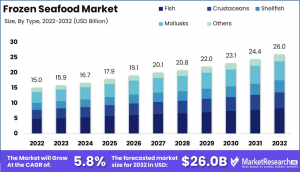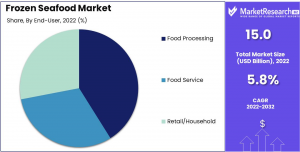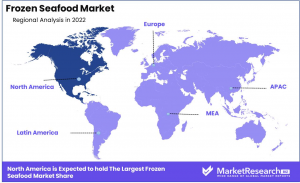Frozen Seafood Market Reaching USD 26.0 Billion by 2032
Frozen Seafood Market size is expected to be worth around USD 26.0 Bn by 2032 from USD 15.0 Bn in 2022, growing at a CAGR of 5.8% from 2023 to 2032.
The frozen seafood industry in North America has seen remarkable growth in recent years, driven by rising consumer demand.”
NEW YORK, NY, UNITED STATES, February 6, 2025 /EINPresswire.com/ -- The global Frozen Seafood Market is set to witness significant growth over the next decade, with its size projected to increase from USD 15.0 billion in 2022 to USD 26.0 billion by 2032, experiencing a compound annual growth rate (CAGR) of 5.8%. This expansion can be attributed to rising consumer demand for convenient, long-lasting food options, increasing awareness of seafood's health benefits, and technological advancements in freezing and packaging methods that enhance product shelf life and quality.— Tajammul Pangarkar
➤ 𝐒𝐚𝐦𝐩𝐥𝐞 𝐑𝐞𝐩𝐨𝐫𝐭 𝐑𝐞𝐪𝐮𝐞𝐬𝐭: 𝐔𝐧𝐥𝐨𝐜𝐤 𝐕𝐚𝐥𝐮𝐚𝐛𝐥𝐞 𝐈𝐧𝐬𝐢𝐠𝐡𝐭𝐬 𝐟𝐨𝐫 𝐘𝐨𝐮𝐫 𝐁𝐮𝐬𝐢𝐧𝐞𝐬𝐬: https://marketresearch.biz/report/frozen-seafood-market/request-sample/
Experts Review
Industry experts highlight that government incentives, such as subsidies and tax benefits for sustainable fishing practices, have played a crucial role in supporting the Frozen Seafood Market's growth. Technological innovations, including improved freezing techniques and smart packaging, are improving product quality and extending shelf life, driving consumer confidence and boosting sales. Investment opportunities in this market are promising, given the increasing consumer demand for healthy, convenient food options. However, industry players must navigate risks such as supply chain disruptions and fluctuating raw material prices. The regulatory environment, with standards ensuring food safety and sustainable fishing, is rigorous but necessary for maintaining consumer trust and market integrity.
Report Segmentation
The market segmentation of the frozen seafood sector is divided into various categories based on product type, end-user, distribution channel, and region. Product types include fish, crustaceans, mollusks, and others, each with its own market dynamics and growth prospects. End users are primarily segmented into households and the food service industry, where frozen seafood is a popular choice due to its convenience and longevity. Distribution channels are notably focused on supermarkets, hypermarkets, online platforms, and specialty stores. Geographically, the market is segmented into North America, Europe, Asia-Pacific, Latin America, and Middle East & Africa, each showing unique growth trends influenced by cultural, economic, and consumer behavior factors.
Key Market Segments
By Type
• Fish
• Crustaceans
• Shellfish
• Mollusks
• Others
By Distribution Channel
• Store-based
• Non-Store-based
By End Use
• Food Processing
• Food Service
• Retail/Household
➤ 𝐁𝐮𝐲 𝐍𝐨𝐰 𝐭𝐡𝐢𝐬 𝐏𝐫𝐞𝐦𝐢𝐮𝐦 𝐑𝐞𝐩𝐨𝐫𝐭 𝐭𝐨 𝐆𝐫𝐨𝐰 𝐲𝐨𝐮𝐫 𝐁𝐮𝐬𝐢𝐧𝐞𝐬𝐬: https://marketresearch.biz/purchase-report/?report_id=41314
Drivers, Restraints, Challenges, and Opportunities
Several factors are driving the growth of the Frozen Seafood Market, including increasing health consciousness, demand for convenient foods, and advancements in freezing technologies that enhance taste and texture. Restraints include logistical challenges in maintaining cold chain management and fluctuating seafood supply due to environmental and regulatory pressures. However, the industry faces challenges, such as consumer skepticism about frozen seafood quality compared to fresh alternatives. Opportunities lie in emerging markets, where rising incomes and changing lifestyles drive demand, and innovation in packaging and preservation technologies can differentiate products in a crowded market.
Key Player Analysis
Key players in the Frozen Seafood Market include industry leaders like High Liner Foods, Nomad Foods, and Marine Harvest, among others. These companies are focusing on expanding their product lines, improving supply chain logistics, and adopting sustainable fishing practices to meet consumer demand and regulatory requirements. They employ strategic partnerships and mergers to expand market reach and invest in marketing strategies to enhance brand recognition and customer loyalty.
• SalMar
• Coast Seafood
• Maruha Nichiro
• High Liner Foods Inc.
• Mowi ASA
• Sysco Corporation
• Trident Seafoods
• Thai Union Group
• Sterling Seafood Corp.
• Clifton Seafood Company
• Marine Harvest ASA
• Austevoll Seafood ASA
• Charoen Pokphand Foods
Recent Developments
Recent developments in the Frozen Seafood Market include the introduction of new products offering exotic and gourmet options to cater to evolving consumer tastes and preferences. Companies are leveraging e-commerce platforms to boost sales and reach a broader consumer base. Transparency in sourcing and sustainable practices is increasingly emphasized, with many companies adopting blockchain technologies for traceability and consumer transparency.
Conclusion
The Frozen Seafood Market is poised for significant growth in the coming decade, driven by consumer demand for healthy, convenient food options and advancements in freezing technologies. While challenges such as supply chain management and regulatory compliance persist, opportunities in emerging markets and technological innovations present promising pathways for industry expansion. The commitment to sustainability and consumer transparency will be pivotal in maintaining growth and consumer trust in the industry.
Lawrence John
Prudour
+91 91308 55334
Lawrence@prudour.com
Legal Disclaimer:
EIN Presswire provides this news content "as is" without warranty of any kind. We do not accept any responsibility or liability for the accuracy, content, images, videos, licenses, completeness, legality, or reliability of the information contained in this article. If you have any complaints or copyright issues related to this article, kindly contact the author above.



